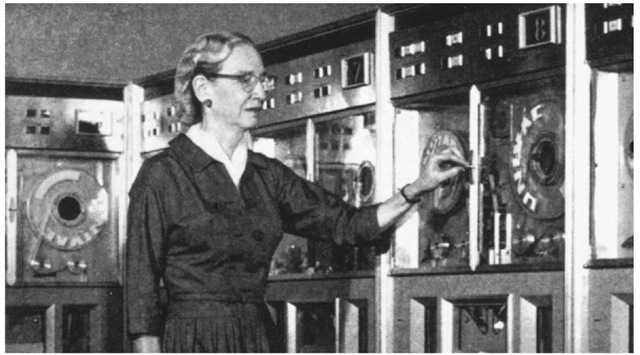Grace Hopper was a pioneer in the field of computer science, helping to invent the first compiler (A-O) as well as the first computer languages (Flow-Matic and COBOL). She got her start with computers in the U.S. Navy during World War II, and she remained in the service until her retirement, after which the navy promoted her to rear admiral, the first woman to hold this rank.
Grace Brewster Murray was born on December 9, 1906, in New York City to Mary, a home-maker, and Walter Murray, an insurance broker. She followed in the footsteps of her great-grandfather, a navy admiral, and her grandfather, a civil engineer who showed her how to survey on field trips together. Murray commenced her long relationship with Vassar College as an undergraduate studying mathematics and physics for her bachelor’s degree in 1928. She proceeded to Yale University for her master’s degree in 1930 and then returned to teach at Vassar while continuing on doctoral work at Yale. During that time, she married Vincent Foster Hopper, an English literature teacher. She received her Ph.D. in 1934 when Vassar promoted her to an instructorship. By 1939, the college had raised her to the rank of assistant professor.
After World War II broke out, Hopper enlisted in the U.S. Navy’s Women Accepted for Voluntary Emergency Services, which assigned her to the Board of Ordnance computing project at Harvard University working under howard hathaway aiken. When she reported to duty on July 2, 1944, he assigned her to the Mark I computer, the prototype of the modern personal computer, although it measured 51 feet long and eight feet high. Hopper and her colleagues were responsible for fixing the machine when it broke, including when a moth flew into its gears; from then on, they called the process of fixing breakdowns debugging. In 1945, Hopper and her husband divorced, and in 1946, Hopper resigned from Vassar to continue on at Harvard even after the war effort ceased, working with the Mark I and its successors, the Marks II and III.
Realizing the vast potential of the computer, she also realized the need for people to transform this potential into understandable programs, so she joined the Univac division of the Remington Rand Corporation in 1949 as a systems engineer. One of her first innovations was a compiler, which allowed the computer to generate its own programs. In 1957, she essentially translated computer languages into plainer English (both for the machine and for the human operating it), resulting in first the Flow-Matic language and later in COBOL (common business-oriented language) in 1959. She climbed the ranks in the company from director of automatic programming to chief engineer to staff scientist by the time she retired in 1971. She continued to climb the ranks simultaneously in the navy, rising to the post of commander by the time she retired in 1979.
Grace Murray Hopper is considered by many to be the mother of the computer and computer languages (Flow-Matic and COBOL).
That year, the Department of Defense awarded Hopper its highest mark of distinction, the Distinguished Service Medal. Six years later, the navy further recognized Hopper by promoting her one final time, to rear admiral, the highest rank ever attained by a woman. She received a host of other honors for her achievements, including the 1946 Naval Ordnance Development Award, the 1973 Legion of Merit, induction into the Engineering and Science Hall of Fame in 1984, and the National Medal of Technology in 1991. She died at the age of 85 on January 1, 1992.

